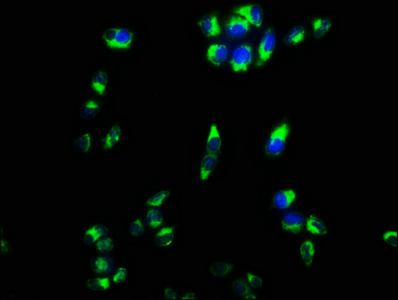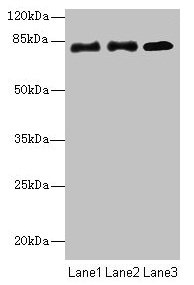CPEB4 Antibody
-
货号:CSB-PA618177LA01HU
-
规格:¥440
-
促销:
-
图片:
-
Immunofluorescence staining of Hela cells with CSB-PA618177LA01HU at 1:133, counter-stained with DAPI. The cells were fixed in 4% formaldehyde, permeabilized using 0.2% Triton X-100 and blocked in 10% normal Goat Serum. The cells were then incubated with the antibody overnight at 4°C. The secondary antibody was Alexa Fluor 488-congugated AffiniPure Goat Anti-Rabbit IgG(H+L).
-
Western blot
All lanes: CPEB4 antibody at 2µg/ml
Lane 1: Hela whole cell lysate
Lane 2: 293T whole cell lysate
Lane 3: U87 whole cell lysate
Secondary
Goat polyclonal to rabbit IgG at 1/10000 dilution
Predicted band size: 81, 79, 37 kDa
Observed band size: 81 kDa
-
-
其他:
产品详情
-
产品名称:Rabbit anti-Homo sapiens (Human) CPEB4 Polyclonal antibody
-
Uniprot No.:Q17RY0
-
基因名:CPEB4
-
别名:CPE binding protein 4 antibody; CPE-binding protein 4 antibody; CPE-BP4 antibody; cpeb4 antibody; CPEB4_HUMAN antibody; Cytoplasmic polyadenylation element binding protein 4 antibody; Cytoplasmic polyadenylation element-binding protein 4 antibody; hCPEB-4 antibody; KIAA1673 antibody
-
宿主:Rabbit
-
反应种属:Human
-
免疫原:Recombinant Human Cytoplasmic polyadenylation element-binding protein 4 protein (244-515AA)
-
免疫原种属:Homo sapiens (Human)
-
标记方式:Non-conjugated
本页面中的产品,CPEB4 Antibody (CSB-PA618177LA01HU),的标记方式是Non-conjugated。对于CPEB4 Antibody,我们还提供其他标记。见下表:
-
克隆类型:Polyclonal
-
抗体亚型:IgG
-
纯化方式:>95%, Protein G purified
-
浓度:It differs from different batches. Please contact us to confirm it.
-
保存缓冲液:Preservative: 0.03% Proclin 300
Constituents: 50% Glycerol, 0.01M PBS, PH 7.4 -
产品提供形式:Liquid
-
应用范围:ELISA, WB, IF
-
推荐稀释比:
Application Recommended Dilution WB 1:1000-1:5000 IF 1:50-1:200 -
Protocols:
-
储存条件:Upon receipt, store at -20°C or -80°C. Avoid repeated freeze.
-
货期:Basically, we can dispatch the products out in 1-3 working days after receiving your orders. Delivery time maybe differs from different purchasing way or location, please kindly consult your local distributors for specific delivery time.
相关产品
靶点详情
-
功能:Sequence-specific RNA-binding protein that binds to the cytoplasmic polyadenylation element (CPE), an uridine-rich sequence element (consensus sequence 5'-UUUUUAU-3') within the mRNA 3'-UTR. RNA binding results in a clear conformational change analogous to the Venus fly trap mechanism. Regulates activation of unfolded protein response (UPR) in the process of adaptation to ER stress in liver, by maintaining translation of CPE-regulated mRNAs in conditions in which global protein synthesis is inhibited. Required for cell cycle progression, specifically for cytokinesis and chromosomal segregation. Plays a role as an oncogene promoting tumor growth and progression by positively regulating translation of t-plasminogen activator/PLAT. Stimulates proliferation of melanocytes. In contrast to CPEB1 and CPEB3, does not play role in synaptic plasticity, learning and memory.
-
基因功能参考文献:
- Silencing of CPEB4 induces reactive oxygen species generation, thus suppressing the Akt expression, which finally prevents non-small cell lung cancer cells invasion and migration. PMID: 29286212
- This study identified a lineage-specific requirement of CPEB4 in malignant melanoma. PMID: 27857118
- Survival analysis revealed a significant association between progression free survival (PFS) and overall survival (OS) and CPEB4 immunohistochemical expression, which was independent in the multivariate analysis. CPEB4 behaves as a significant predictor of prognosis in stage IV colorectal carcinoma. PMID: 28551384
- The results implicate the potential role of CPEB4 and Vimentin in breast cancer metastasis, which is further confirmed by the finding that there is a physical interaction between the two proteins. PMID: 28536077
- CPEB4 and IRF4 expression in peripheral mononuclear cells are potential prognostic factors for advanced lung cancer PMID: 27113098
- downregulation of CPEB4 likely occurs at the late cancer stage to facilitate HCC progression. Biphasic alteration of CPEB4 expression during HCC progression suggests its complicated role in tumorigenesis PMID: 27158894
- positive cytoplasmic polyadenylation element binding protein 4 expression predicted a worse prognosis in glioma patients, and cytoplasmic polyadenylation element binding protein 4 could represent a useful biomarker or therapeutic target for glioma. PMID: 28381179
- high expression of CPEB4 was found to be an independent prognostic biomarker for overall survival in colorectal cancer patients PMID: 27771769
- Our studies first validated that CPEB4 interacts with Vimentin and indicated that high CPEB4 expression in astrocytic tumors correlates closely with a clinically aggressive future, and that CPEB4 might represent a valuable prognostic marker for patients with astrocytic tumors. PMID: 26546435
- Low CPEB4 expression and high CPEB1 expression were independent predictors of overall survival in glioma patients. PMID: 27000226
- findings imply that posttranscriptional deregulation of CPEB4 contributes to the inhibited cell proliferation and the enhanced cell apoptosis in colorectal cancer, and directly targeting CPEB4 by miR-203 might be a strategy in colorectal cancer treatment PMID: 26361147
- Evidence that CPEB4 uses both its RNA recognition motifs to maintain optimal RNA binding. PMID: 25081215
- CPEB4 is a candidate biomarker for defining metastatic cancers and directing personalized therapies. PMID: 24045092
- Knockdown of CPEB4 expression significantly facilitated HCC cell migration and invasion. PMID: 23145039
- CPEB4, an RNA binding protein that mediates meiotic mRNA cytoplasmic polyadenylation and translation, is overexpressed in pancreatic ductal adenocarcinomas and glioblastomas, where it supports tumor growth, vascularization and invasion. PMID: 22138752
显示更多
收起更多
-
亚细胞定位:Cytoplasm. Cell projection, dendrite. Cell projection, dendritic spine. Cell junction, synapse, postsynaptic density. Cell projection, axon. Cell projection, growth cone. Endoplasmic reticulum. Cytoplasm, perinuclear region.
-
蛋白家族:RRM CPEB family
-
组织特异性:Expressed in pancreas in islets and ductal cells (at protein level). Expressed in melanocytes.
-
数据库链接:
HGNC: 21747
OMIM: 610607
KEGG: hsa:80315
STRING: 9606.ENSP00000265085
UniGene: Hs.127126
Most popular with customers
-
-
YWHAB Recombinant Monoclonal Antibody
Applications: ELISA, WB, IF, FC
Species Reactivity: Human, Mouse, Rat
-
-
-
-
-
-























